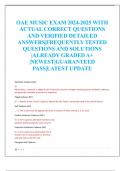OAE MUSIC EXAM 2024-2025 WITH
ACTUAL CORRECT QUESTIONS
AND VERIFIED DETAILED
ANSWERS|FREQUENTLY TESTED
QUESTIONS AND SOLUTIONS
|ALREADY GRADED A+
|NEWEST|GUARANTEED
PASS|LATEST UPDATE
Authentic Cadence (AC)
V-I
Many times, a seventh is added to the V chord for an even stronger resolving sound. Authentic cadences
are generally classified as perfect or imperfect.
Plagal Cadence (PC)
IV - I. Known as the 'church' cadence. Named for the 'Amen' commonly used at the end of hymns.
Half Cadence (HC)
_ - V. The V chord can be approached from a number of other chords (I, ii, IV, V/V)
Perfect Authentic Cadence (PAC)
V-I or V7-I cadence with both chords in root
position and final soprano note on tonic
Imperfect Authentic Cadence (IAC)
V-I or V7-I cadence in which either the V
chord is not in root position or the final
soprano note is not the root.
Phyrigian Half Cadence
1|Page
,iv6-V in minor
Deceptive Cadence (DC)
A cadence that creates the expectation of going to I, but substitutes another chord instead. Common
substitutes for I are: vi, IV6, bVI, and occasionally IV or V/ii.
Jazz music composed in 1940s
swing jazz
Jazz music composed in the 19
dimenduendo
gradually softer
divertimento
an instrumental composition in several movements, light and diverting in character, similar to a
serenade
Conjunt motion
stepwise motion
contrary motion
when two parts move in opposite directions
double period
four phrases in two pairs, cadence at end of second pair is stronger than cadence at the end of the first
pair
asymmetrical period
A period containing two phrases of differing length.
parallel period
both phrases begin with similar material
contrasting period
When two phrases begin different
Ostinato
a continually repeated musical phrase or rhythm
retrograde music
A musical line which is the reverse of a previously or simultaneously stated line
Baroque Suite
2|Page
,an instrumental form consisting of several contrasting dance movements in the same key and in binary
form. The four basic movements are: allemande, courante, sarabande, and gigue.
a musical form that does not return to pervious material
Tablature
A system of NOTATION used for LUTE or other plucked string instrument that tells the player which
strings to pluck and where to place the fingers on the strings, rather than indicating which NOTES will
result. Tablatures were also used for keyboard instruments until the seventeenth century.
throughbass
Shape Notes
a system of notation in which shaped note heads indicate scale degrees
tone poem
a one-movement work for orchestra of the Romantic era that gives musical expression to the emotions
and events associated with a story, play, political occurrence, personal experience, or encounter with
nature
seralism
music that is based on a particular succession of pitches, rhythms, dynamics or other elements that are
repeated over and over to provide underlying stucture of the composition
tone cluster
a dissonant group of closely adjacent pitches; clusters on the piano are usually produced with the fist or
forearm
Franz Joseph Haydn
(1732-1809) Classical composer who spent most of his life as musical director for wealthy Esterhazy
brothers; visits to England introduced him to world of public concerts rather than princely patrons;wrote
The Creation and The Seasons
George Frideric Handel
(1685-1759) German-born composer who rose to fame and glory working for the British kings in London.
He composed operas, oratorios, suites and sonatas for the entertainment of the London public and the
royal court. Famous works inclusding The Messiah
The tone poem Les Préludes, by Franz Liszt
Les Préludes, symphonic, or tone, poem by Hungarian pianist and composer Franz Liszt that premiered
in 1854 in Weimar, in the grand duchy of Saxe-Weimar-Eisenach (now in Germany). It is the best known
of Liszt's 13 symphonic poems and is by turns reflective, martial, and majestic.
The tone poem Ein Heldenleben by Richard Strauss
3|Page
, Ein Heldenleben (A Hero's Life), Op. 40, is a tone poem by Richard Strauss. The work was completed in
1898. It was his eighth work in the genre, and exceeded any of its predecessors in its orchestral
demands.
Richard Strauss
(1864-1949) German composer wrote symphonic poems before turning to operas seeking to follow
Wagner. Salome based on an Oscar Wilde play, is harmonically brilliant and bombastic, with prolonged
dissonance
Franz Liszt
(1811-1886), Hungarian piano virtuoso, Well-known and influential composer, piano teacher and
conductor, Known for dramatic and flamboyant performances
The Tone Poem Ma Vlast by Bedřich Smetana
Má vlast combines the symphonic poem form, pioneered by Franz Liszt, with the ideals of nationalistic
music of the late nineteenth century. Each poem depicts an aspect of Bohemia's countryside, history, or
legends.
The works have opened the Prague Spring International Music Festival, on the 12 May anniversary of the
death of their composer, since 1952.[5]
Bedřich Smetana
Bohemian composer of operas and symphonic poems, founder of the Czech national school of music. He
was the first truly important Bohemian nationalist composer.
sonata-allegro form
a dramatic musical form that originated in the Classical period involving an exposition, development,
and recapitulation, with optional introduction and coda
- style of Hayden, Brams, Beethoven
Rhythmic augmentation
Lengthening of rhythmic values
Rhythmic Diminution
shortening of rhythmic values
through-composed form
vocal form in which there is new music for each stanza of a poem
allegro
quarter note = 120 bpm
Johann Sebastian Bach
4|Page





